Personas are fictional characters you create based on research, and they represent segments of your market.
We can’t emphasize enough how important that research is because personas cannot be built on internal assumptions. You might start with internal assumptions, but they must then be validated by real customers and always updated as you learn and evolve.
When a company devotes consummate time and effort to fine-tuning its personas, it can bring a whole host of benefits to the table.
Why do marketers use buyer and user personas?
Let’s set the scene and say you’re launching an online, AI transcription company and during your persona work, you discover that:
- Persona A's goals are to transcribe meeting notes more quickly, and
- Persona B's goals are to ensure the quality of case study transcriptions.
When you’re marketing to persona A, your message might be more along the lines of: “Spend less time decoding meeting notes and more time acting on the outcomes,” and persona B’s angle might be more like: “Take your case studies from audio to written with accuracy ensured throughout.”
By tailoring your approach to meet each persona’s goals, you’re getting on their level and resonating with what they want and need, not what someone else wants and needs - and that understanding can work wonders for your revenue.
How important are personas in marketing?
When done right, personas first and foremost help you create products your personas are crying out for and guide the roadmap in terms of priorities. Product marketers often forget about this role personas play but it’s crucial, you must build for your personas, and if you want to build the right products and features for the right people, this persona work is paramount.
The second piece to personas is that they equip you with the tools you need to effectively market your product to specific audiences in a way that resonates with them, targets their touchpoints, and increases conversions, because as with any type of marketing, personalization is key, and all this helps to shape how your sales and marketing teams encourage people to buy.

Thirdly, your personas help your engineers keep those end users in mind as they’re building out any products or features, and this kind of focus is key in ensuring what’s built is what people want.
And finally, personas are important for your support teams because they help them understand why someone might have bought your product in the first place, and what’s important to them when they talk to them, and all this comes together to create a better, more tailored customer experience all-round.
“Messaging gets a lot of the glory - pretty much gets all the glory, right? When you see a great ad campaign put together when you see a great content piece, you look at it, and you're like, "Wow, this is awesome. Oh, it had such great ROI. It produced these results and everything".
“I guarantee you that every good marketing piece has a solid foundation of a deep understanding of customers. It's kind of that silent base that really informs all good product marketing - personas are the foundation.”
Misha Rangel, Director of Enterprise Product Marketing at Veeam Software
What makes a good customer persona?
Misha Rangel, Director of Enterprise Product Marketing at Veeam Software, (formerly of IBM), explained what makes a good persona:
It really comes down to a few basic things that seem very basic, and it will take constant iteration and perfection to accomplish this.
- Understanding your customer,
- Understanding what problems they have,
- How does your product help them solve the problems?
- And this is the secret weapon to help you nail your positioning.
If you cannot answer all of these questions with confidence, if your teams cannot answer these questions, if your sales teams can't answer the questions, then there are going to be problems.
Not only are we as product marketing in charge of crafting this, but we also have to take the huge step of adoption and making sure everyone is enabled and consistently saying the same message.
How many personas do I need?
You should have approximately 3-5 personas, alongside their identified characteristics.
When creating personas, it’s the general consensus that less is more; if you create too many, this can dilute your messaging.
Where can personas be used?
Honestly? Almost everywhere. Specifically, though, they should feed into your:
• Sales enablement collateral like battle cards and sales scripts.
• Product or feature launch assets - like landing pages, blogs, onboarding flows, and product demos.
• Positioning and messaging work - different personas might require different positioning and will almost certainly require different messaging.
• OKRs and analysis, in that you might want to track metrics against individual personas, rather than collectively, to understand how each performs in isolation.
And then for your sales teams, it’ll be in the form of differentiated pitches - whether that be over the phone or via email, for customer success it could impact how they liaise with customers and handle complaints, for marketing personas will feed into everything from PPC, referral and retargeting campaigns to blog posts, website copy and social media posts, and then for product they can help mold the future of their roadmap.
For example, going back to Skyscanner, if you discover persona A’s main barrier is that they can’t see flight prices for more than 12 months in advance, maybe a new feature could be predictive flight prices for up to 24 months after today’s date.
The number of touch points your persona work will have will vary depending on your business's unique structure, so it’s worth sitting down with those same people you gathered at the beginning of the process to understand how your personas could slot into their various activities and objectives.
The last thing we’ll touch on to take your persona work to the next level is connecting those dots between a customer’s stage in the buying funnel to what content they need, and then tailoring that content to each persona. The example above is a pretty standard buying funnel graphic you’ve probably seen a lot.
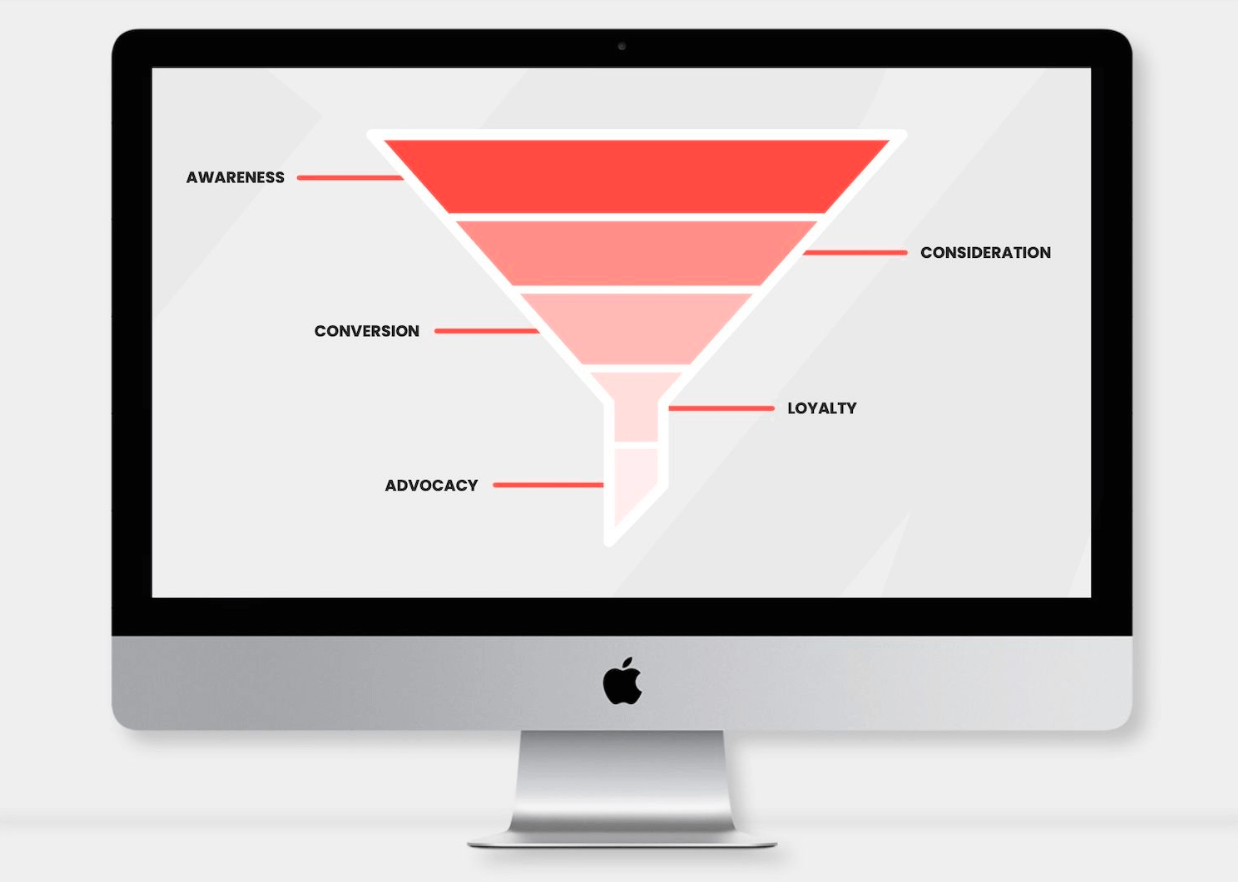
At that first awareness stage, potential customers are probably just having internal conversations around things like:
- Do we have a problem here?
- Does this need to be a problem?
- How much will it cost us to fix this problem?
When you jump over to that consideration stage, you’re looking at sticking points like:
- Will this solution solve 100% of my problem?
- How easy is this solution to use?
- Is there anyone out there who’s better at solving it?
And then when you move along again to intent, they start looking at things like:
- Who else is using this product?
- How soon can I get it up and running?
Each of these stages of the funnel requires different content pieces to meet the customer’s needs and to take your efforts to the next level. Those content pieces should meet specific persona requirements - yes, that means more work, but it’ll also likely result in a much better, more optimized funnel.
Customer persona examples
What are buyer persona examples?
Once you’ve combined your interviews and identified trends, you need to input all that information into persona documents that can be shared with other internal teams.
There’s no right or wrong when it comes to the format, but here are a couple of examples to get you started.
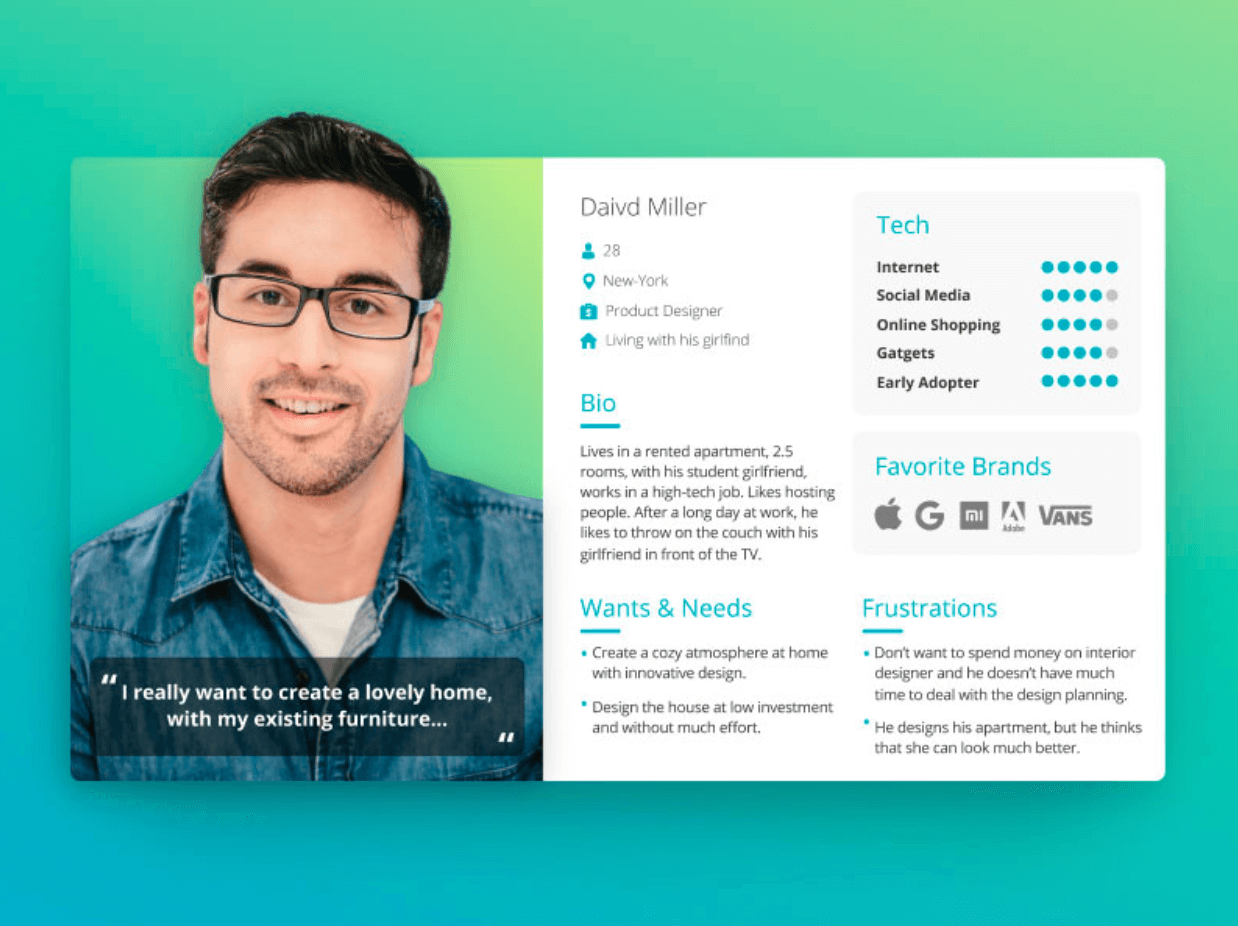
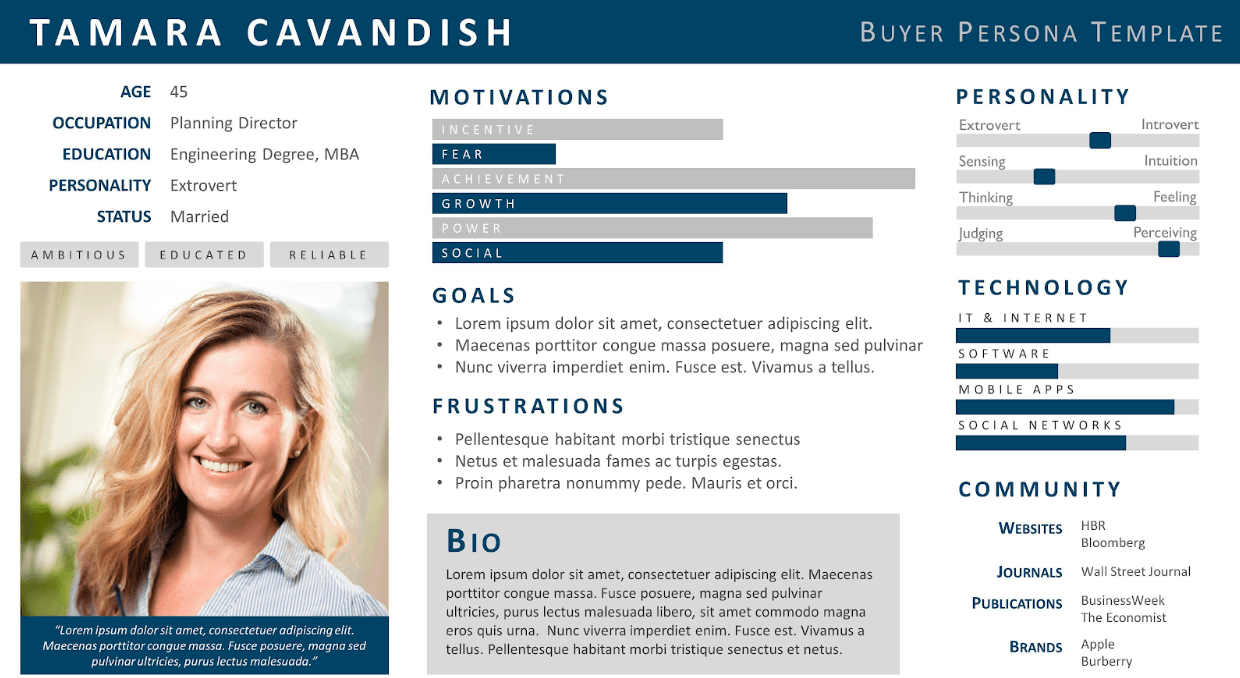
What are user persona examples?
User personas can be defined by a host of key characteristics including:
- Gender,
- Age,
- Budget,
- Their main goal,
- Pain points.
The character created by a company is either the epitome of an existing customer or representative of the type of customer a company aspires to attract in the future; these can be formed by communicating with users.
After a company has communicated with its users, it can then be segmented further into an assortment of demographics and psychographic data. These findings are used to enhance the overall output from a product marketing team and form representative user personas for the company.
Consider the following your sources of inspiration:
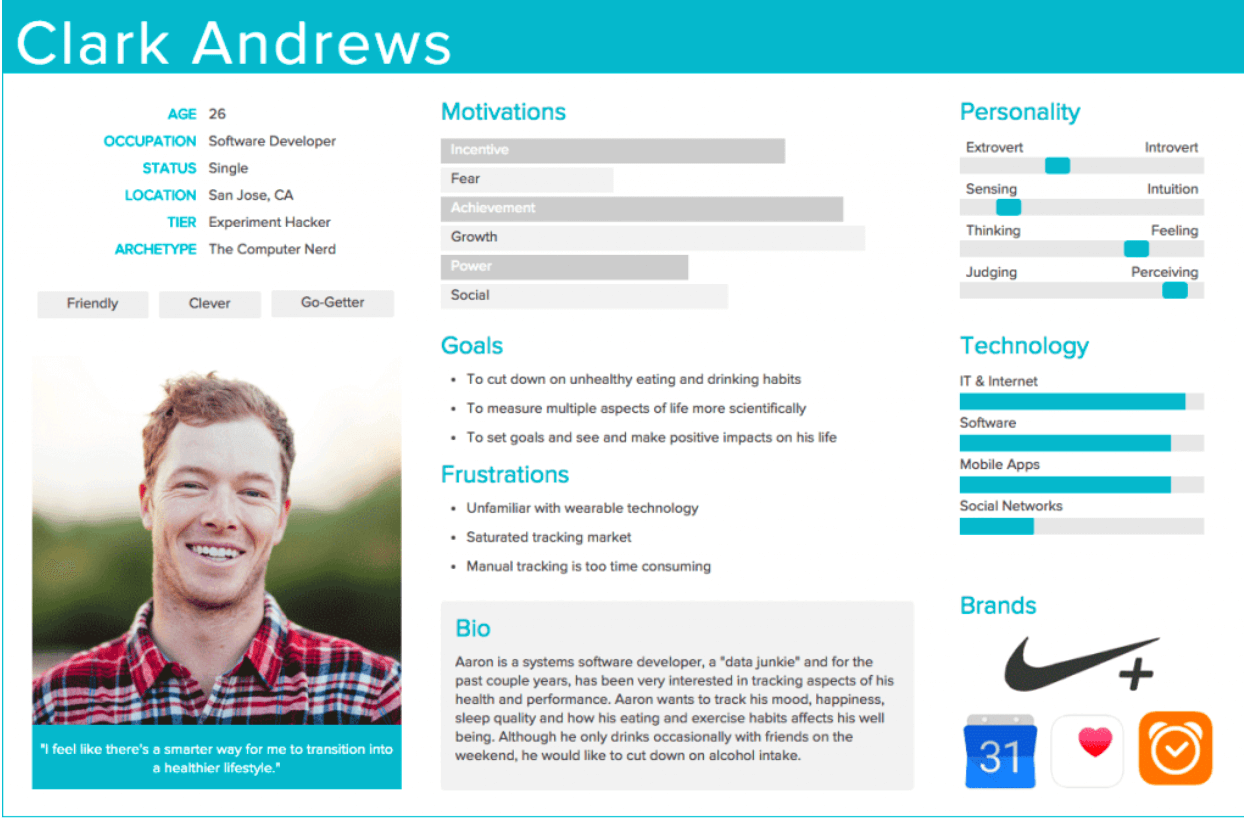
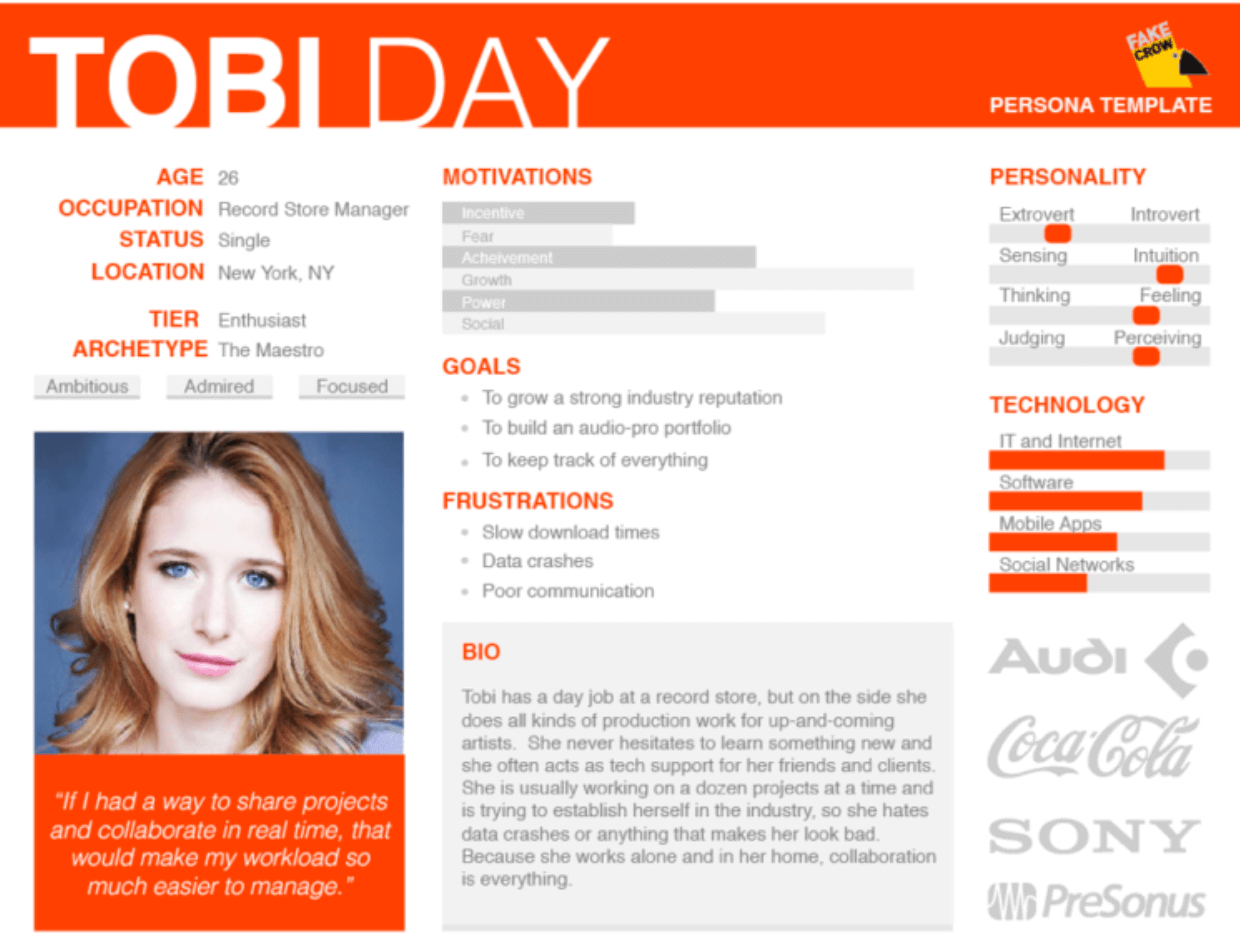
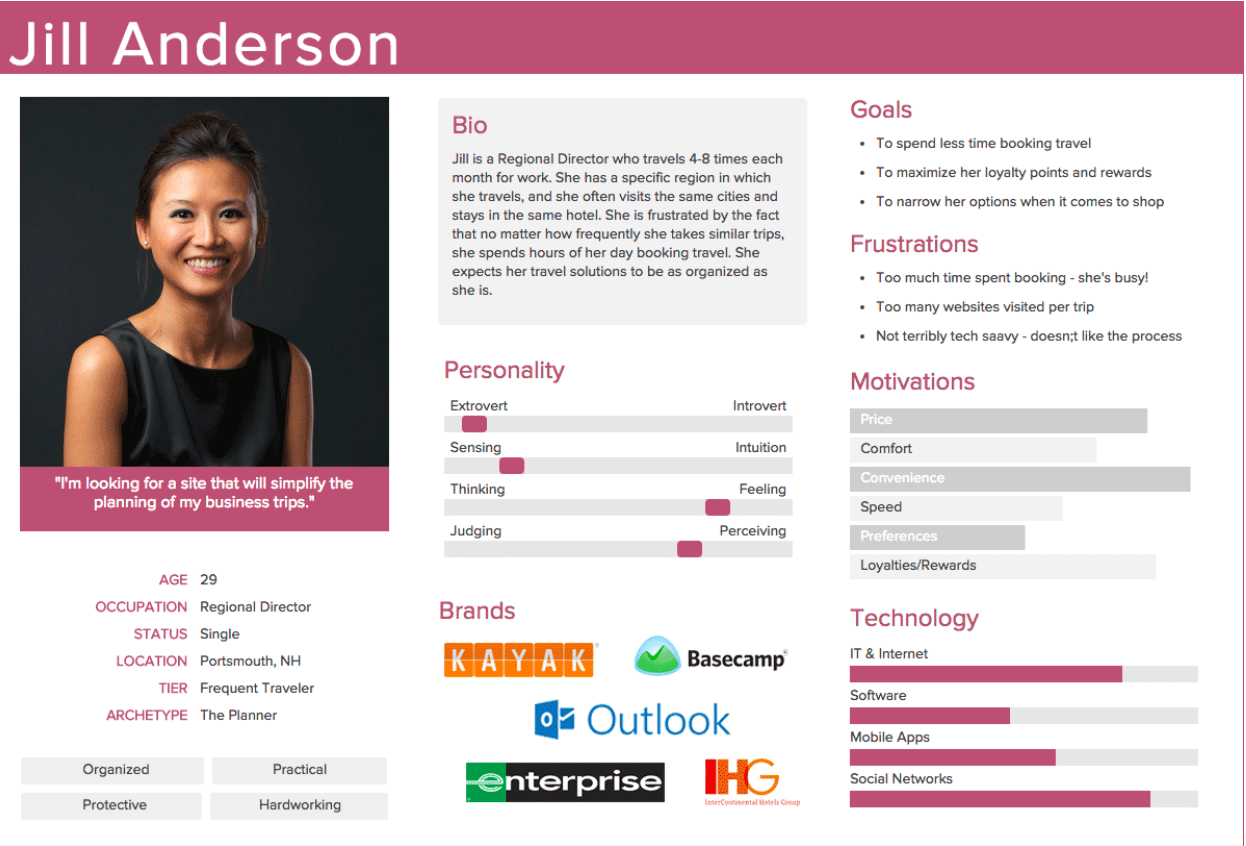
Download our free B2B user persona template here and get stuck in.
What are negative personas?
If a standard persona is a reconstruction of your ideal customer, a negative persona is a representation of who you don’t want to target as a customer.
It could be somebody who is only engaging with your SaaS product for research purposes or people who are just too expensive to acquire (due to a low average sale price or how unlikely it is they'll purchase again).
Occasionally, you might see negative personas referred to as 'exclusionary' personas but it all means the same thing - profiling the people you aren’t trying to sell to.
A great way to demonstrate negative personas in action is to take social media ads as an example.
If a company based in North America offers social media ads targeting well-established companies with 200+ staff then a negative persona would be companies with no online presence, less than a year of experience, a workforce of 10 people, and offices outside of North America.
It’s as simple as that.
The benefits of negative personas
Similar to standard personas, negative personas can help shape marketing strategies and the direction of sales efforts.
As the old saying goes, there are two sides to every story and negative personas can be equally as valuable as regular, straight-up personas. Perhaps not in financial return and monetary value, but certainly in enriching your customer marketing insight and finetuning your target demographic.
Good product marketing is about getting to know who isn’t interested in what you have to offer, as well as those who are. It’s about knowing who you don’t want to force down the sales funnel as well as those you do.
“Product marketing teams must understand negative buyer personas to understand the people who don’t fit the profile of their target audience, and therefore not to spend their or other teams’ time on.”
Bryony Pearce, Chief Marketing Officer at Product Marketing Alliance
This information enables you to really hone in on your target customer(s) and understand which segment of the market has an appetite for your product - knowledge that can be gained through also lifting the lid on those who aren’t quite so hungry for more.
One of the best ways to get to know something is by assessing its opposite, or its counterpart.
Take the seasons for example: through understanding the nuances of summer versus winter, we get to know what times of year will be most fruitful for sowing seeds and harvesting crops. Strawberries, for instance, flourish in the warm sunlight of summer, while root vegetables and leafy greens are more suited to winter climes.
What we can learn here from Mother Nature is that by making yourself aware of the full picture, you endow yourself with a strong 360-degree perspective from which to steer your product marketing function.
Acquainting yourself with both sides of the coin, so to speak, will make your product-market fit, GTM strategy, sales enablement, customer marketing - and all that other good stuff - so much more well-rounded.
Negative personas are particularly insightful for businesses in their infancy in the process of developing a target demographic. However, companies of all shapes and sizes can reap the rewards of creating negative personas.
Other benefits of negative personas include:
- Keeping the cost of acquisition down as targeting becomes more effective when you’re communicating with people who want to listen. Identifying the wrong customers can help guide you toward the right ones.
- Save the time and energy of your sales function, to make sure they’re only investing effort and resource into valuable places, by getting rid of dead-end prospects.
- More clarity around your desirable personas and their characteristics.
- They can help you refine your marketing and communications.
Negative personas aren’t just about weeding out the people who aren’t interested in your product. Ironically, they can have a super positive impact on your product marketing strategy.
How to identify negative personas
The first thing you need to do is know what kind of characteristics to look out for in an undesirable buyer or user.
Some common negative persona characteristics (or red flags 🚩) include:
- Customers who made it into the sales funnel but never closed (or came with a high acquisition cost).
- Leads or prospects that are unattainable (this could be for a whole variety of reasons such as budget or geographical location).
- Behaviors or patterns that are costing the company more money than the person is making in return.
- Unavoidable identity factors that don’t align with your offering or target audiences, such as age, culture, and gender.
If any of the people coming your way fall into categories like these, they’ve likely got ‘negative persona’ written all over them.
Nailing your negative personas is also a lot about trial and error. As you go along, you can do win/loss analysis and customer analysis to establish who is converting and who is dropping off.
Amongst those you’re losing will be your negative personas. If the relationship is right, you might consider interviewing lost customers to establish more information about why they were an unsuitable fit for your product.
Focus on:
- Why they were challenging?
- Did they consume too much time and money?
- Were they unhappy with your product and/or service?
- Did any specific issues arise?
- What were their goals, and why didn’t they align?
- How aggressive were their goals?
- Were they difficult to manage? If so, why?
- What were their biggest pain points?
Over time, you can begin to develop a list of characteristics that you believe profile your anti-customer. Again, this will enable you to take a stronger approach to how you define the customers you do want to attract and nurture.
Right, now we’ve filled up your tank with negative persona knowledge, we want to leave you with one last little sneak peek from our Personas Certified course content:
“You don’t speak the same way to your friends as you do to people who you’ve just met, and you don’t speak the same way to people you’ve just met as you do to your business partners, or your parents, or your grandparents.
"You tailor your message to each and every one of them and when you’re explaining to people in your surroundings what you do for a job, you don’t explain it the same to your grandmother, your mother, and your friends. So why should business be any different?”
The difference between user and buyer personas
There are two types of personas you’ll become accustomed to as a product marketer: user personas and buyer personas.
The main difference between a user persona and a buyer persona is what is said on the tin. The buyer persona buys the product, and the user persona uses the product. That said, there can be a bit of crossover, in that in some cases, the buyer might be both the buyer and user - it’s on you to uncover this during your research.
For example, let’s say you buy your dad a set of brand-spanking-new golf clubs. Each of you takes on a different persona; you’re the buyer, but he’s gonna be the one carving up the course like a wannabe Woods, therefore, he takes on the role of the user.
The same logic can also be applied to the B2B market. For instance, a construction business may have a go-to provider they use to source their building materials. While the head of the company is the buyer in footing the bill for bricks and concrete, the workers on the site are using the product.
“That’s all well and good, but what about buyer personas?”
Don’t worry, we’re not wrapping up yet; we’ve plenty more persona expertise up our sleeves.
Daniel Palay, Product Marketing Consultant and Persona Development Expert (and PMA ambassador 😉) specializes in building and strengthening user and buyer personas, and in this article, he offered an insight into the what, why, and how of sales-focused buyer personas.
How to gain a deeper understanding of your buyer
1. Conversations with your sales team
Your sales teams meet these buyers day in and day out and they have a wealth of knowledge that you can tap into [only if you ask them].
Meet with your sellers on a regular basis and ask them more about their meetings with prospects and customers.
a. Who did they meet? And what was the buyer’s title?
b. Which industry they are aligned to?
c. What is their organization size and structure and who is the buying center and who holds the budget?
d. What are some of the initiatives that their prospects are working on?
e. What are their needs and wants? Drill deeper to understand your buyer’s emotional attributes – their fears and desires after your sales teams have had subsequent meetings with the buyer.
2. Conversations with your prospects and existing customers at Tradeshows
Tradeshows and user forums are great places not only to network but also to gain deeper insights into your existing customers and potential buyers. Remember your existing customer was a buyer before!
Before you demo your product or dive deep into your coolest product features, take a step back to know more about your buyer.
With the obvious questions outlined above, also ask them about their business problem and why they are on this shopping spree. Talk to them and understand their aspirations, motivations and where they want to be in their career, and what they think would make them successful.
Ask them where they go to learn and find information. Open your ears and put your listening skills to the best use to “know them and their language”.
I hear you. There are budget cuts and we don’t travel enough to meet them. You may be thinking about how you can leverage your digital marketing programs to gain insights about your buyer.
The good news is... You can!
3. Tap audience data from your digital tactics
Your buyer is hanging out online looking and evaluating your product and your competition’s product.
If you have invested in a MarTech stack, you can access audience insights that show who has responded to your campaign. That should have wealth of data for you to investigate. Look through the content assets that they have downloaded and engaged with, and look through the webinars that they have attended.
All this data put together can give you a picture of their topics of interest. Go to the online communities that they go to gain knowledge and see the types of questions and problems they post to seek solutions.
Stack Overflow, and LinkedIn communities are great places to start for tech buyers. You can also use your social listening tools to get a download of the conversations they are engaging with on social channels. There is plenty of data if you open your eyes and look!
These are some pointers for you to get started. You can do more than these 3 and keep enriching your understanding of your buyer through other means which can help you better target them and build relevant campaigns.
Use all this information and document it and build an empathy map and keep refreshing it from time to time to keep it fresh with changing buyer needs and aspirations.

How to use personas effectively
Eventually, you’ll have your persona ready and raring to work for you, but that doesn’t just happen by itself. You might know how they’re gonna shape your campaigns and plans but for teams outside of product marketing, it’s not always as simple as that and it’s on you to demonstrate the role and value of these persona documents.
So, to make sure all your hard work doesn’t go to waste, set up meetings with the people who benefit from these personas and explain what they are, how they will benefit them, and when and how they can be used.
We’d recommend separating these meetings and speaking to people on a team level and the reason for this is the benefits and use cases will vary a lot depending on who you’re talking to.
For example, for your demand-gen team, it might be that they can now create hyper-targeted ads for each persona.
For sales, it might be that they can tailor their calls to specific goals. For content marketing, it might be that they can create tailored landing pages that speak directly to that persona’s pain points, and so on.
Book those meetings and make sure you clearly articulate the value to each team, but then don’t stop there. Around two to four weeks later, put another meeting in their calendar to check in and see if or how those personas have benefited their teams. If they listened to you and implemented them this conversation will provide you with valuable feedback.
If they didn’t listen and the personas have been left untouched, it’ll give them another nudge to take action. To drive that adoption it could be worth including internal case studies in those follow-up meetings.
For example, if your PPC team or some of your sales reps started personalizing their ads and calls using your persona documents and saw an uplift in conversions, use those stats to hammer home the importance and value of them. As soon as people see and understand tangible, data-driven benefits like that, the adoption will take care of itself.
How to create a buyer persona
Your personas need to be built with real information from real people - using your gut instinct won’t do.
Remember, creating personas is all about understanding audiences you already know to want to buy from you; not people you wish would buy from you.
Buyer personas can be created in six steps:
Step 1: Collaboration
The first step is getting other business departments involved. Personas shouldn’t be created in a product marketing vacuum and you’re by no means the only team who’ll use them.
Sales will use them to personalize their pitches, customer success might use them during their conversations, and product teams might use them to shape their roadmaps, and then there are your marketing (including content and growth marketing), engineering, and account executive teams too.
If you don’t bring these teams into the process you run the risk of creating personas that are hyper-relevant to you, but miss the mark and important details for other people to get the most out of them, and if they’ve not got the right information in, driving uptake is going to be very much an uphill battle.
So, step one is mapping out who else should be involved in the process and bringing all those people together for the next phase.
Step 2: Outline goals
Start by working backward and first understanding what you want to achieve from your persona interviews. Without these goals in place coming up with the right questions will be tough and unlikely to render the results you need.
So, with all the relevant stakeholders in a room, sit down and start brainstorming what information would be really useful in your personas, and how people can use that information in certain scenarios - looking into this is important because personas aren’t supposed to be pages and pages long.
You have a finite amount of space, which means everything that’s in there has to be valuable, and some people might think knowing the persona’s age, for example, is essential, but when it boils down to it that might not be the case.
During this meeting, take tons of notes but don’t promise anything. Go away, reevaluate all the requests you’ve got, and then use your product marketing expertise to whittle down what will and won’t make the cut to create the most effective persona.
And remember, just because something doesn’t make sense to be included in the persona, doesn’t mean you can’t still ask the questions - knowledge is power wherever that knowledge lives, persona or not.
Step 3: Question time
Once you know the aim of your persona work it’s time to sit down and understand which questions will pull out the answers you need and in your head, remember to follow each question up with a ‘why’.
Using Skyscanner as an example, let’s say you want to understand the motivations behind why Jon, the husband and father of three, books a family vacation each year.
You might ask something as simple as “What’s the reason you and your family go on holiday every year?” and he might say something along the lines of “Because I like to treat the family and have two weeks of solid family time".
Most people leave it there, but if you ask “Why?” again, you’ll drill deeper into the motivator and could uncover information like “I work 60+ hours a week and don’t normally get much family time throughout the year” or “My parents could never afford a family holiday when I was young and I want to make sure my kids get that,” and so on.
All these tidbits of knowledge add up and create the most complete pictures of your personas.
Let’s take a look at another example using the fictitious transcription company we mentioned earlier, and let’s say one of the things you want to validate with real customers is a day in their life.
Here are a few questions that would help you understand that answer:
• What are your main responsibilities?
• Who do you report to?
• What does your immediate team look like?
• Do you manage anyone else? If so, who?
• What takes up most of your time?
• What slows you down?
• Which teams do you interact with most?
• How many hours do you typically work a day?
Step 4: Interviews
Once you’ve worked out what information you need and what questions you need to ask to get it, it’s time to go out and start speaking to people, and that includes both prospects and customers.
In terms of the medium, it’s always best to speak to interviewees either over the phone or in person. This will enable you to gather more robust data and pick your customers’ brains outside of your ‘script’ and ask those ‘why’ questions. Face-to-face can be tricky if you’re a global organization, but something as simple as a Zoom call can get you face-to-face from opposite sides of the world.
If you struggle to get customers to sign up for a call with you consider adding an incentive to the call - honestly, you’d be surprised at how far a $50 Amazon voucher can get you.
This incentive doesn’t always have to be monetary either, it could be inviting them to your Customer Advisory Board, or giving them early access to a new product, for example.
Also, when you’re conducting your persona interviews, don’t forget to record the conversation so you can play it back at a later date - and ask for permission too, of course.
Although it’s a good idea to make notes throughout, it’s unlikely you’ll be able to take sufficient notes while being attentive on the call, so this allows you to carefully play the callback and make sure you’re not missing any important details.
Here are a few tips for this part of your persona work:
- When you’re inviting people to take part, make sure you’re clear that the call won’t be sales-related at all. Any whiff of this can be a huge deterrent.
- Although prospects will be harder to get time with, don’t use this as an excuse to neglect them. Prospects can be great because they’re not involved with your product and are unbiased. Also, try to speak to people who haven’t heard about you at all; that’ll give you a great look into how perceptions and expectations differ.
- When you’re reaching out to customers, don’t just go after the ones that rave about you. Going after the good and bad will give you a more complete picture and more to go at in terms of learning what your customers’ challenges are and how you can overcome this and eradicate them to bring more future customers in.
For example, if it becomes apparent that customers in persona A find your product too technical to understand that provides an opportunity to a) deliver an education piece to people who fall into that persona to ensure they’re able to get the most out of your product and stay loyal, and b) it can shape how your target prospects who sit in that persona, and you might decide to strip back and simplify how you take about your product even more. - Support your interview recruitment by asking people for referrals. For example, if you’ve finished your persona interview with Jane, before you hang up, ask her if she knows anyone who fits the bill and might be willing to spare 15-20 minutes to help you out. This introduction can give you a nice in and saves you some time sourcing people yourself.
When it comes to how many people you need to talk to, there isn’t a set number. The more the better, but, as a rule, for a persona to be considered credible you should aim for between 5 - 10 matching patterns.
Outside of your core persona work, there are other ways you can look to continually top up your knowledge base too, like:
• Adding a couple of fields to your website’s form,
• Including relevant questions as part of your onboarding process, and
• Getting your sales and customer success teams to ask certain questions before, during, or after their prospect and customer conversations.
If you do this though, just remember to make sure you’ve got a central location to store their findings - a simple spreadsheet or Slack channel ought to do.
Step 5: Consolidation
If more than one of you is conducting persona calls and/or consolidating the data, make sure you have a standard process in place before you get to work - if you’re all using different documents it’ll make cross-referencing and validating your findings much harder. This doesn’t need to be complex and could be something as simple as:
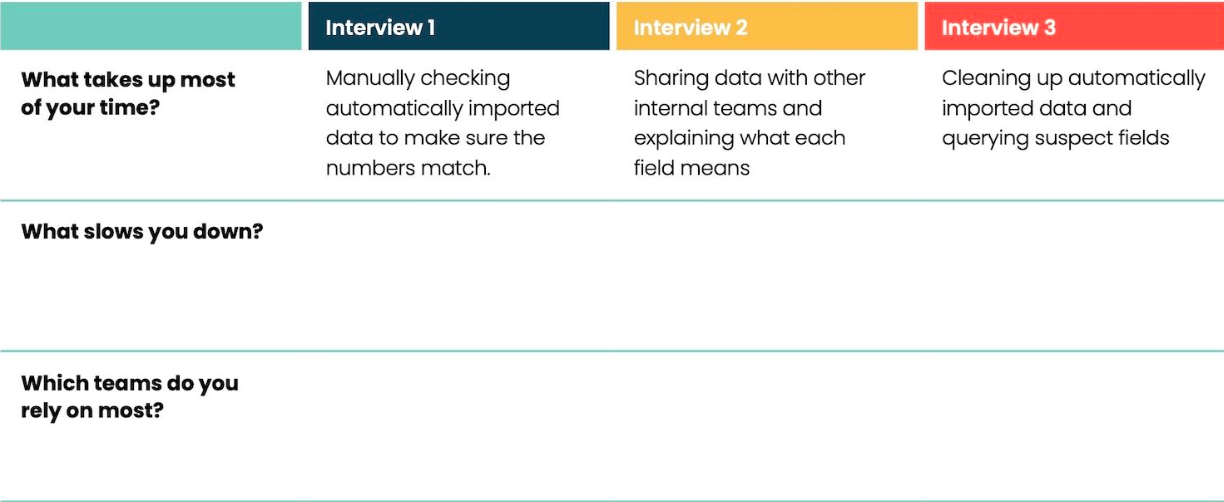
If you’re not picking up any trends, as painful as it might be, just keep going and keep speaking to people until you identify a clear pattern.
Step 6: Persona documents
Last but not least, once you’ve consolidated your interviews and identified trends, you need to input all that information into persona documents that can be shared with other internal teams.
There’s no right or wrong when it comes to the format of these.
Each format for your personas may differ, and that’s fine. It’s all about figuring out which works best for your set-up, and how the people who’ll be using them are most likely to digest and use them, and then coming to a solution based on that.
Once you have that final version we’d recommend including space for a ‘Last reviewed’ field so you can easily keep on top of how fresh they are and ensure everyone’s working off the most recent version.
Quantitative or qualitative research?
Misha Rangel, Director of Enterprise Product Marketing at Veeam Software, outlined the role qualitative and quantitative research play when building personas, and gave insights on how she used specific software to support the persona-building process during her time at IBM:
Quant is the start
A lot of times we have access to a lot of data as product marketers, we're usually data people, we could pour through data. I love some Gartner Forrester reports and looking at charts and everything like that.
Sometimes, especially around personas, this is the end of our analysis. "Our customer is this percent likely and on the survey, they ranked this as their number one priority so we should go here". We are done with the job.
At IBM, we have a great resource of a research team that prepares analyst reports and does their own first-party research and everything like that. Amazing tool, but we can't just take what they give us, and then pass it over.
We have to take another level of qualitative data on top of that. The way to do this is through interviews.
But don’t forget to layer on interviews!
This is easier at some companies than it is at others but I can't overemphasize the importance of interviewing.
If you are at a company that is an enterprise, you can't necessarily call up the CTO of JP Morgan Bank and talk to them on the phone, there are some other things you can do.
Number one, talk to people in your network that have similar titles, talk to business partners, talk to sales, talk to customer support, and really advocate for getting some face time with customers.
Whether that's at an event, a CAB, or a customer support event, those are really invaluable to understanding your customers.
Try some personality research
Crystal - this was my secret weapon. I promise you, I do not have stock in Crystal, but I probably should because I talk about them a lot and give them a lot of props.
There's a tool out there called Crystal and it is this really cool AI personality research tool. It's a plugin that you download, and that you could put on LinkedIn.
When you go to someone's profile on LinkedIn, you click the little Crystal button and it does some crazy AI analysis and tells you what their personality is.
There are maybe 10 different personality types - really fascinating stuff and really scary stuff if you want to look up yourself and see what it says.
How we use Crystal at IBM is we took a list of titles that were a fit with our customer base, and I had my team go and research people on LinkedIn that had that title.
So, who is the global Chief Technology Officer at JP Morgan? Andrew Lang.
Will I ever get to talk to Andrew Lang on the phone? Probably not but I can look him up and 30 or 40 people like him on LinkedIn and look at their Crystal profile.
As you can imagine, a lot of CTOs/CIOs fall into a very similar personality profile. Just as a lot of product marketers fall into a similar product marketing personality profile. You start to see similarities in the personalities.
The one thing I do like about Crystal, if you look at this screenshot at the bottom, it shows you some emotional indicators, which is a lot of what is missing from personas.
Personas are different from segmentation. Segmentation is what your role is, what your gender is, and how old you are.
What a lot of times is not covered is what motivates you, what your strengths are, and what the ways you prefer to be communicated with are. Those are very important nuances to take that persona development to the next level.


 Follow us on LinkedIn
Follow us on LinkedIn


